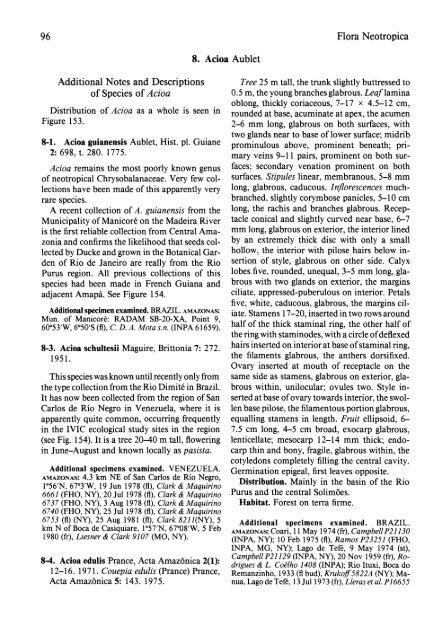flora neotropica - CNCFlora
flora neotropica - CNCFlora
flora neotropica - CNCFlora
You also want an ePaper? Increase the reach of your titles
YUMPU automatically turns print PDFs into web optimized ePapers that Google loves.
96 Flora Neotropica<br />
Additional Notes and Descriptions<br />
of Species of Acioa<br />
Distribution of Acioa as a whole is seen in<br />
Figure 153.<br />
8-1. Acioa guianensis Aublet, Hist. pl. Guiane<br />
2: 698, t. 280. 1775.<br />
Acioa remains the most poorly known genus<br />
of <strong>neotropica</strong>l Chrysobalanaceae. Very few col-<br />
lections have been made of this apparently very<br />
rare species.<br />
A recent collection of A. guianensis from the<br />
Municipality of Manicore on the Madeira River<br />
is the first reliable collection from Central Ama-<br />
zonia and confirms the likelihood that seeds col-<br />
lected by Ducke and grown in the Botanical Gar-<br />
den of Rio de Janeiro are really from the Rio<br />
Purus region. All previous collections of this<br />
species had been made in French Guiana and<br />
adjacent Amapa. See Figure 154.<br />
8. Acioa Aublet<br />
Tree 25 m tall, the trunk slightly buttressed to<br />
0.5 m, the young branches glabrous. Leaf lamina<br />
oblong, thickly coriaceous, 7-17 x 4.5-12 cm,<br />
rounded at base, acuminate at apex, the acumen<br />
2-6 mm long, glabrous on both surfaces, with<br />
two glands near to base of lower surface; midrib<br />
prominulous above, prominent beneath; primary<br />
veins 9-11 pairs, prominent on both surfaces;<br />
secondary venation prominent on both<br />
surfaces. Stipules linear, membranous, 5-8 mm<br />
long, glabrous, caducous. Inflorescences muchbranched,<br />
slightly corymbose panicles, 5-10 cm<br />
long, the rachis and branches glabrous. Receptacle<br />
conical and slightly curved near base, 6-7<br />
mm long, glabrous on exterior, the interior lined<br />
by an extremely thick disc with only a small<br />
hollow, the interior with pilose hairs below insertion<br />
of style, glabrous on other side. Calyx<br />
lobes five, rounded, unequal, 3-5 mm long, glabrous<br />
with two glands on exterior, the margins<br />
ciliate, appressed-puberulous on interior. Petals<br />
five, white, caducous, glabrous, the margins cil-<br />
Additional specimen examined. BRAZIL. AMAZONAS: iate. Stamens<br />
Mun. of Manicore: RADAM SB-20-XA, Point<br />
17-20, inserted in two rows around<br />
9,<br />
60?53'W, 6?50'S (fl), C. D. A. Mota s.n. half of the thick staminal<br />
(INPA 61659).<br />
ring, the other half of<br />
the ring with staminodes, with a circle ofdeflexed<br />
8-3. Acioa schultesii Maguire, Brittonia 7: 272. hairs inserted on interior at base of staminal ring,<br />
1951.<br />
the filaments glabrous, the anthers dorsifixed.<br />
Ovary inserted at mouth of receptacle on the<br />
This species was known until recently only from same side as stamens, glabrous on exterior, glathe<br />
type collection from the Rio Dimite in Brazil. brous within, unilocular; ovules two. Style in-<br />
It has now been collected from the region of San serted at base of ovary towards interior, the swol-<br />
Carlos de Rio Negro in Venezuela, where it is len base pilose, the filamentous portion glabrous,<br />
apparently quite common, occurring frequently equalling stamens in length. Fruit ellipsoid, 6-<br />
in the IVIC ecological study sites in the region 7.5 cm long, 4-5 cm broad, exocarp glabrous,<br />
(see Fig. 154). It is a tree 20-40 m tall, flowering lenticellate; mesocarp 12-14 mm thick; endoin<br />
June-August and known locally as pasista. carp thin and bony, fragile, glabrous within, the<br />
cotyledons completely filling the central cavity.<br />
Additional specimens examined. VENEZUELA. Germination<br />
AMAZONAS: 4.3 km NE of San Carlos de Rio<br />
epigeal, first leaves opposite.<br />
Negro,<br />
1?56'N, 67?3'W, 19 Jun 1978 (fl), Clark &<br />
Distribution.<br />
Maquirino<br />
Mainly in the basin of the Rio<br />
6661 (FHO, NY), 20 Jul 1978 (fl), Clark & Maquirino<br />
Purus and the central Solimoes.<br />
6737 (FHO, NY), 3 Aug 1978 (fl), Clark & Maquirino Habitat. Forest on terra firme.<br />
6740 (FHO, NY), 25 Jul 1978 (fl), Clark & Maquirino<br />
6753 (fl) (NY), 25 Aug 1981 (fl), Clark 8211(NY), 5 Additional<br />
km N<br />
specimens examined. BRAZIL.<br />
of Boca de Casiquiare, 1?57'N, 67008'W, 5 Feb AMAZONAS: Coari, 11<br />
1980 (fr), Liesner & Clark 9107<br />
May 1974 (fr), CampbellP21130<br />
(MO, NY).<br />
(INPA, NY); 10 Feb 1975 (fl), Ramos P23251 (FHO,<br />
INPA, MG, NY); Lago de Tefe, 9 May 1974 (st),<br />
8-4. Acioa edulis Prance, Acta Amaz6nica<br />
Campbell P21129 (INPA, NY), 20 Nov 1959 (fr), Ro-<br />
2(1):<br />
drigues & L. Coelho 1408 (INPA); Rio Ituxi, Boca do<br />
12-16. 1971. Couepia edulis (Prance) Prance, Remanzinho, 1933 (fl bud), Krukoff5822A (NY); Ma-<br />
Acta Amazonica 5: 143. 1975.<br />
nua, Lago de Tefe, 13 Jul 1973 (fr), Lleras et al. P16655

















